No species too small
By Abby Hade Terpstra on September 27, 2017 in Blog
Iowa was once home to an amazing array of animal species, providing habitat to a diverse mix of mammals, birds, reptiles and insects. Some of these species are now threatened. Learn more about some of the smallest creatures INHF works to protect.
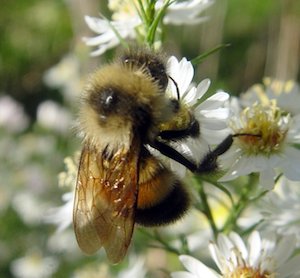 Rusty Patched Bumblebee
Rusty Patched Bumblebee
Bombus affinis
Federally Endangered as of 2017
The Rusty Patched Bumblebee lives in colonies with a single queen and female workers. It is found in grasslands with abundant flowers April through September and nests underground or in grass clumps. The range of the bee once spread throughout the upper midwest and northeast, but has significantly declined as the grasslands and tallgrass prairie habitats have been destroyed, fragmented or degraded. Since 2000, the bee has been seen in only 13 of the 28 states in its range. It has been documented in Black Hawk, Clayton, Johnson and Winneshiek counties in Iowa.
When you think of a bumblebee, this is what you think of — black head, yellow fuzzy body, with the males and workers having the rust colored patch on their backs that gives the bee its name.
This brand new endangered designation will definitely impact management strategies as we begin to understand what the bee needs. For example, burn schedules may alter to ensure that the bees are out of hibernation before last year’s dry grasses are lit. And this new designation will open up even more public education opportunities on the plight of our native pollinators.
INHF is already involved in many actions around protecting pollinators and their needed habitats, including co-sponsoring a recent Linn County Landowner Forum on how to add pollinator habitat to your land and protect the pollinator habitat you already have. “To have an impact, we’ll need to work with private landowners,” said Joe McGovern, INHF president. “Luckily that’s one of our specialties.”
The Iowa Monarch Conservation Consortium, which includes INHF, formed in 2015 to support monarch butterfly recovery in Iowa and North America. The monarch has become the mascot of the native pollinator’s plight and is currently under review to be added as a federally endangered species. The protection of pollinator habitat that is good for Rusty Patched Bumblebees will be good for monarchs too, no doubt. And the protection of native pollinators is certainly key to protecting many other species. Photo by Ilona L.
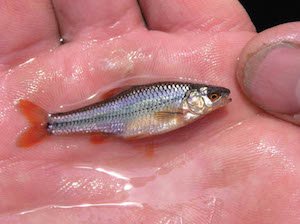 Topeka Shiner
Topeka Shiner
Notropis topeka
Federally Endangered in 1998, changed to Experimental Population in 2013
State Threatened
The Topeka Shiner is a small minnow less than three inches long, silverygreen with a dark stripe down the side and a pearly belly. It lives in pooling areas of small prairie streams in the central United States that have good water quality and cool-to-moderate temperatures. The Topeka Shiner lives in 13 of the 36 Iowa counties where it once was found, with populations restricted to the North Raccoon River and its tributaries. Smaller populations can currently be found in the Boone, Rock and Little Rock rivers.
This little fish is fighting against habitat destruction, especially of river oxbows (bends), from sedimentation caused by development and in-stream gravel mining, changes in water quality, predatory fish, stream channelization and dam construction.
INHF worked with private landowners and the U.S. Fish and Wildlife Service (USFWS) along West Buttrick Creek in the early 2000s to restore oxbows that would support Topeka Shiners. “Almost immediately three landowners stepped forward to volunteer,” said INHF President Joe McGovern, who was land stewardship director at that time. Once cleared of silt, these naturally occurring pooling places along historic creek beds fill with groundwater. “Not long after restoration, we searched and found shiners in there, just like that,” McGovern said. “It was a great and quick success.” Photo by INHF
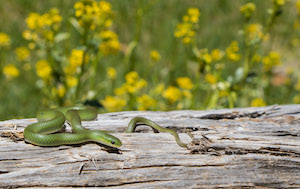 Smooth Green Snake
Smooth Green Snake
Opheodrys vernalis
State Species of Special Concern
Beautifully bright green with a light yellow or cream underbelly, the smooth green snake grows 12 to 22 inches long. They live in grassy moist meadows, prairies or clearings of coniferous pine forests and hibernate in rock crevasses or burrows. Smooth green snakes are non-venomous and are one of the few snake species that eat only insects, preferring crickets, grasshoppers and smooth caterpillars.
Fewer than 10 populations of smooth green snakes are left in Iowa due to habitat fragmentation and destruction, human captivity and especially its sensitivity to pesticides.
INHF land stewardship interns have been lucky enough to encounter smooth green snakes while working at Wildin Heritage Prairie, an 80-acre property that INHF owns in Kossuth County. When INHF purchased the land from an estate in 2002, it had never been drained or plowed, though it did have a history of grazing. A cluster of small prairie potholes and high quality remnant sedge meadow prairie held many species of conservation interest that INHF has worked to protect and restore.
“Sometimes you have to take a chance on the land,” said Heather Jobst, INHF senior land conservation director. “It was grazed for so long, but we took the chance and now there is a significant species living there.” Photo by Ashley Tubbs
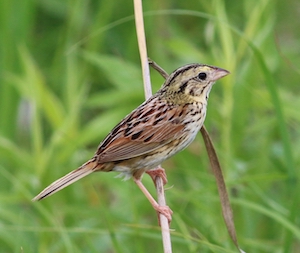 Henslow’s Sparrow
Henslow’s Sparrow
Ammodramus henslowii
State Threatened
A shy and secretive bird with an underwhelming song delivered from a low perch, Henslow’s Sparrow’s distinction lies in its plumage — bold streaking on its back, wings and throat, and an olive head with dark eyelines and whisker marks.
The habitat needs of Henslow’s Sparrow are not well understood, as often this loner can’t be found in an area that seems to be suitable. Fields, meadows and grasslands greater than 100 acres in the Great Lakes region with no grazing or haying are seemingly preferred.
Large tracts of established, undisturbed grassland are rare in Iowa. The loss and fragmentation of the prairie, along with trees invading these open spaces, has contributed to the sparrow’s decline.
Neal Smith National Wildlife Refuge in Prairie City is the largest tallgrass prairie reconstruction in the nation at 5,600 acres. It recently grew for the first time in over a decade when INHF and Friends of Neal Smith National Wildlife Refuge helped with the purchase of a property surrounded on three sides by the refuge. Putting together a large, uninterrupted piece of prairie will continue to offer picky birds like Henslow’s Sparrow a safe place to live. Next time you’re at Neal Smith NWR, listen closely for the easily-missed “feeble hiccup” of song from this little brown bird. Photo by Tom Benson
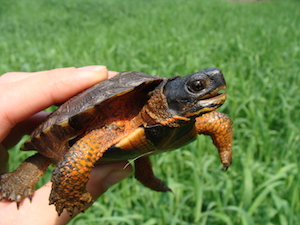 Wood Turtle
Wood Turtle
Glyptemys insculpta
Federally under review
State Endangered
The wood turtle has a knobby shell with plates bearing patterns like the growth rings of a tree. Its rough skin warms from dark brown at the toes to the glow of burnished cedar wood near the shell. The plastron (the shell that covers the belly) is a rich orangey-yellow with black splotches. A wood turtle’s tail can be as long as its shell.
Wood turtles are found in the Great Lakes region of the United States and Canada. In Iowa, they are only in the northeast corner along the Cedar River. They need clear streams, rivers or woodland ponds that are near forests.
Since these turtles don’t always lay eggs every year, and only eight to 10 eggs are in a clutch, they reproduce very slowly. They need space and time in the right conditions to establish and breed.
When a 55-acre property in Butler County came up for auction in 2015, Butler County Conservation Board (BCCB) knew it had exciting potential. The floodplain woodland was right next to their West Fork Forest Access on the West Fork of the Cedar River and, in addition to providing water quality benefits, would provide great habitat for deer, turkey, small mammals, amphibians and reptiles. A known population of wood turtles have been found in Big Marsh Wildlife Area, a public area just north of the property, and were tracked by University of Northern Iowa’s Dr. Jeff Tamplin, to the property.
INHF held the land for BCCB until funding was secured. A collaborative grant with U.S. Fish & Wildlife Service is creating wood turtle habitat in the area by restoring the woodland, clearing invasive species and encouraging bur oak growth.
“Hopefully this will entice a few turtles to nest on the property,” said Ross Baxter, INHF land projects director. “Adding to the scope of habitat possibilities will give these wood turtles a place to spread to.” Photo by U.S.F.W.S
.JPG) Iowa Pleistocene Snail
Iowa Pleistocene Snail
Discus macclintocki
Federally Endangered as of 1978
State Endangered
This minute snail carries a brown or greenish white, tightly coiled shell that is less than ¼” in diameter. It is found on algific talus slopes — rare, moist hillsides where temperatures stay cool even in the summer from air and water flowing past underground ice through cracks in the slope. Nationally, there are only 31 sites where the Pleistocene Snail has been found. All but one of those sites are in Iowa, and those sites are only in Clayton, Clinton, Dubuque, Fayette and Jackson counties.
“Preservation and management of algific talus slope landscapes is vital to protect potential snail populations, as well as other species that need those slopes,” said Brian Fankhauser, INHF blufflands director. Management efforts include controlling invasive species like Garlic mustard, bush honeysuckle and European buckthorn; preventing grazing on the steep, fragile slopes that can easily be damaged by livestock walking across them; and preventing logging activities on or across the slopes since dragging logs damages the soils and unique plant communities.
INHF worked in cooperation with the U.S. Fish and Wildlife Service (USFWS) to hire four temporary technicians in 2014 and six in 2015 for a statewide snail monitoring effort. “These technicians were an integral part of the USFWS’s Recovery Plan,” said Erin Van Waus, INHF conservation easement director. While INHF has helped protect algific talus slopes in Winneshiek and Allamakee counties, so far there’s been no documentation of Pleistocene Snails on those areas. “They won’t be there if we don’t protect the habitat,” said Heather Jobst, INHF senior land conservation director. “It’s a first step.”
This is one of many species that depend on a very specific habitat, like the Fitch’s Elephanthopper that was recently found at INHF’s Heritage Valley in Allamakee County. That rare insect is only found in high-quality native prairie. Photo by INHF
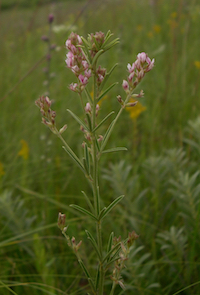 Prairie Bush Clover
Prairie Bush Clover
Lespedeza leptostachya
Federally Threatened as of 1987
State Threatened
Prairie Bush Clover is in the pea family and is also known as Slender-Leaved Bush Clover. The spindly plant with a silver sheen grows 9-18 inches tall. A loosely arranged open spike of pale pink flowers blooms in mid-July for a short time. Its characteristic silvery green seed pods form even from flowers that don’t fully open.
Found in Iowa, Illinois, Minnesota and Wisconsin in dry and tallgrass prairies with damp to well-drained soil, the type of prairieland where prairie bush clover once thrived is the same land that is highly coveted for crop ground. Many surviving populations are clinging to the edges of areas that are too steep for plowing. More than 60 percent of the known populations of prairie bush clover are on private land, where landowners are practicing light grazing, haying or are intentionally preserving a prairie remnant.
Dickinson County Conservation Board added 79 acres to the Judd Wildlife Area in 2013 with INHF’s help. This permanently protected a high quality remnant prairie, a tributary of the Little Sioux River and two fens, the rarest type of wetlands found in Iowa. Because the habitats on the property transition from very wet (hydric) to mesic prairie to very dry (xeric), the diversity in both plant and animal species is amazing. Surveys identified the federally threatened prairie bush clover along with three bird species of greatest conservation need, two rare minnows and eleven other plant species of special concern, including the state threatened Desert Biscuitroot. Such rich diversity is worth preserving. Photo by U.S.F.W.S
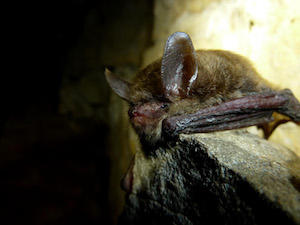 Northern Long-Eared Bat
Northern Long-Eared Bat
Myotis septentrionalis
Federally Threatened as of 2015
This small and richly furred brown bat is about three inches long with a nine to ten inch wingspan. Its name comes from its ears, which are indeed longer than the ears of other bats in the Myotis genus.
This bat’s range extends widely, covering the eastern United States from the Florida panhandle up and extending into Canada’s lower territories. In the summer you can find long-eared bats roosting in colonies or singly under bark or in cavities and crevasses of trees and snags. Winter hibernation happens in caves or mines.
The largest threat to these bats comes from a fungal disease known as White Nose Syndrome. Populations in the northeastern United States have seen 99% decimation. While there is currently no official Iowa DNR designation for Northern long-eared bats in Iowa, it is listed in the Iowa Wildlife Action Plan as a species of greatest conservation need, recognizing how critical it is to take action before White Nose arrives.
We’ve learned much about bat needs already from the protection of another federally Endangered Species, the Indiana bat. INHF helped protect the Sodalis Nature Preserve in Hannibal, Mo. — a winter hibernaculum for hundreds of thousands of Indiana bats as well as other bat species, including the long-eared. Long-eared and Indiana bats have been found during a recent survey of the 1,000+-acre Heritage Hills in central Iowa, which is in the process of transferring from INHF to the Iowa DNR. “Managing for one bat species is, luckily, managing for the other,” said Ryan Schmidt, INHF land stewardship director. Photo by U.S.F.W.S
GLOSSARY
Endangered Species
Any species of fish, plant or wildlife which is in danger of extinction throughout all or a significant part of its range.
Threatened Species
Any species which is likely to become an endangered species within the foreseeable future throughout all or a significant portion of its range.
Species of Special Concern
Any species about which problems of status or distribution are suspected, but not documented.
Experimental Population
Species treated as Threatened Species on public land, for consultation purposes, and as species proposed for listing on private land.
Definitions from U.S. Fish & Wildlife Service and Iowa Department of Natural Resources